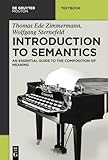Introduction to Semantics : An Essential Guide to the Composition of Meaning / Thomas Ede Zimmermann, Wolfgang Sternefeld.
Material type: TextSeries: Mouton TextbookPublisher: Berlin ; Boston : De Gruyter Mouton, [2013]Copyright date: ©2013Description: 1 online resource (291 p.)Content type:
TextSeries: Mouton TextbookPublisher: Berlin ; Boston : De Gruyter Mouton, [2013]Copyright date: ©2013Description: 1 online resource (291 p.)Content type: - 9783110308006
- 9783110314373
- 420.1/43 23
- P325 .Z56 2013
- online - DeGruyter
- Issued also in print.
| Item type | Current library | Call number | URL | Status | Notes | Barcode | |
|---|---|---|---|---|---|---|---|
 eBook
eBook
|
Biblioteca "Angelicum" Pont. Univ. S.Tommaso d'Aquino Nuvola online | online - DeGruyter (Browse shelf(Opens below)) | Online access | Not for loan (Accesso limitato) | Accesso per gli utenti autorizzati / Access for authorized users | (dgr)9783110314373 |
Frontmatter -- Preface -- Contents -- Chapter 1: Literal Meaning -- Chapter 2: Lexical Semantics -- Chapter 3: Structural Ambiguity -- Chapter 4: Introducing Extensions -- Chapter 5: Composing Extensions -- Chapter 6: Quantifiers -- Chapter 7: Propositions -- Chapter 8: Intensions -- Chapter 9: Presuppositions -- Chapter 10: Compositional Variable Binding -- Solutions to the Exercises -- References -- Index
restricted access online access with authorization star
http://purl.org/coar/access_right/c_16ec
This textbook helps undergraduate students of language and linguistics taking their first steps in one of the core areas of grammar, introducing them to the basic ideas, insights, and techniques of contemporary semantic theory. Requiring no special background knowledge, the book starts with everyday observations about word meaning and use and then hightlights the role of structure in the analysis of the meanings of phrases and clauses, zooming in on the fascinating and vexing question of how speakers manage to meaningfully communicate with sentences and texts they have never come across before. At the same time, the reader becomes acquainted with the modern, functionalist characterization of linguistic meaning in terms of reference (extension) and information (intension), and learns to apply technical tools from formal logic to analyzing the meaning of complex linguistic expressions as being composed by the meanings of their parts. Each of the nine main chapters contains a variety of exercises for self-study and classroom use, with model solutions in the appendix. Extensive English examples provide ample illustration.
Issued also in print.
Mode of access: Internet via World Wide Web.
In English.
Description based on online resource; title from PDF title page (publisher's Web site, viewed 25. Jun 2024)


